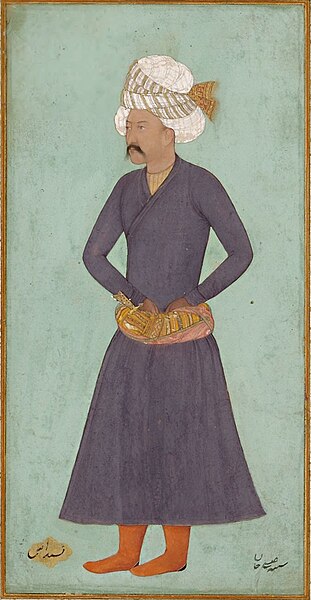File:Portrait of Isa Khan, Qurchibashi of Shah 'Abbas I. Ascribed to Bishn Das, Agra, India, dated 1618.jpg

Original file (681 × 1,313 pixels, file size: 133 KB, MIME type: image/jpeg)
Captions
Captions
Summary[edit]
| DescriptionPortrait of Isa Khan, Qurchibashi of Shah 'Abbas I. Ascribed to Bishn Das, Agra, India, dated 1618.jpg |
Accession Number: AKM153 Place: Agra, India Dimensions: 36.9 x 24.7 cm Date: 1618 Materials and Technique: Opaque watercolour, gold, paper Safavid Iran had much contact with its Indian neighbours to the east, the Mughals, and its artistic legacy, passed down from the Timurids, often served as a source of inspiration for Mughal art and architecture. In fact, the second Mughal emperor, Humayun (r. 1530-40 CE and 1555-56 CE), spent considerable time at the Safavid court after the Afghan sultan conquered his Indian territories. The Safavid Shah Tahmasp (r. 1524-76 CE) welcomed the exiled ruler and helped him reclaim the Mughal throne a few years later. Diplomatic relations continued between Iran and India during the reign of Shah 'Abbas I (r. 1587-1629 CE), the high point of Safavid power. This portrait, once identified as representing Shah 'Abbas I, is ascribed at the lower left to Bishn Das (“Bishndas”), a Mughal portraitist favoured at the court of Jahangir (r. 1605-27 CE). As foreign embassies often travelled with their own artists, it is possible that Bishndas accompanied the envoy of the Mughal Khan 'Alam, stationed in Iran from 1618-19 CE (Canby 1998, p. 139). In the late twentieth century, scholars suggested that the figure in the painting was 'Isa Khan (d. 1632 CE), the qurchibashi, or commander-in-chief, of the king’s royal guard. The justification behind this identification comes from a reading of the Persian inscription at the lower right of the painting as “shabih-i 'Isa Khan” (the likeness of 'Isa Khan). Appointed as qurchibashi in 1612-13 CE, 'Isa Khan is mentioned by Iskandar Beg Munshi in the latter’s history of Shah 'Abbas. His prominent status is underscored by the fact that the king’s successor, Shah Safi' (r. 1629-42 CE), had 'Isa Khan executed three years after he ascended the throne (Eskander Beg Monshi 1978, vol. 2, p. 1309; Canby 1998, p. 140). It would therefore not seem unusual for Bishndas to record the likeness of a pre-eminent courtier as one of the portraits painted on his visit. On the other hand, however, the inscription appears more clearly legible as “shabih-i 'Ali Khan”, which encourages further research on the identity behind this name as well. |
| Date | |
| Source | http://warfare.tk/Persia/Isa_Khan-Qurchibashi_Of_Shah_Abbas_I-large.htm (original piece in the Aga Khan Museum[1]) |
| Author | ascribed to Bishn Das |
Licensing[edit]
| Public domainPublic domainfalsefalse |
|
This work is in the public domain in its country of origin and other countries and areas where the copyright term is the author's life plus 70 years or fewer.
| |
| This file has been identified as being free of known restrictions under copyright law, including all related and neighboring rights. | |
https://creativecommons.org/publicdomain/mark/1.0/PDMCreative Commons Public Domain Mark 1.0falsefalse
File history
Click on a date/time to view the file as it appeared at that time.
| Date/Time | Thumbnail | Dimensions | User | Comment | |
|---|---|---|---|---|---|
| current | 07:43, 22 July 2012 |  | 681 × 1,313 (133 KB) | Mohafezekaar (talk | contribs) |
You cannot overwrite this file.
File usage on Commons
The following 2 pages use this file:
File usage on other wikis
The following other wikis use this file:
- Usage on az.wikipedia.org
- Usage on en.wikipedia.org
- Usage on fa.wikipedia.org
- Usage on pnb.wikipedia.org
- Usage on ru.wikipedia.org
- Usage on wikisource.org
- Usage on tr.wikipedia.org
- Usage on ur.wikipedia.org
- Usage on uz.wikipedia.org
- Usage on www.wikidata.org
Metadata
This file contains additional information such as Exif metadata which may have been added by the digital camera, scanner, or software program used to create or digitize it. If the file has been modified from its original state, some details such as the timestamp may not fully reflect those of the original file. The timestamp is only as accurate as the clock in the camera, and it may be completely wrong.
| JPEG file comment | Created with GIMP |
|---|